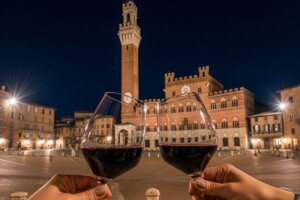The focus is on environment and social networking is an important trend but still a niche. This is wine tourism according to the Italian foundation Censis and Cities of Wine’s 11th report “Observatory on Wine Tourism in Italy”, the organization of the most wine-oriented municipalities in Italy, which was presented yesterday at the BIT event in Milan. The quality of the environment is still the main appeal factor (23%), while wine & food has margin for improvement, since it is stable at number four. The Internet is the main tool used by travellers to organize their wine tourism experiences (89.2%), and more and more Italian municipalities are meeting that need by going online (88.3%).
Furthermore, wine tourism is untouched by the crisis, but a national strategy is needed: 85% of the mayors and 61% of trade professionals think that the selection of new destinations could be widened even more. The most wine & food oriented territory in Italy is Cuneo, thanks to both top-tier wine producers and restaurateurs, followed by Verona and Siena. The wine tourism market has not yet reached maturity and it follows the wine market: it grew (+12% in 2012 over 2011) thanks to the stream of new foreign tourists, which make up for the drop in Italian ones. “Wine tourism”, said Pietro Iadanza, President of Cities of Wine, “must be a primary focus for the next Italian government”.
Rather surprisingly, however, wine & food isn’t the first among the reasons for wine tourism travel: environment is number one (23%), followed by art & culture (19%), fairs and events (19%), then wine & food (17%) and wine (13%). But how can we attract more tourists? By giving more power to communication, and first of all web communication, as it is the main tool that tourists use (89.2%), followed by word-of-mouth (76.9%), specialized guides (44.6%), “Strade del Vino” tours (24.6%), travel agencies (23.1%), magazines (16.9%) and tourist promotion agencies (18.3%).
But there is a tool that has been the spark of many a discussion: the sojourn tax, which is currently being applied in very few places (only 14% of Italian municipalities use it and 2% more will follow), but that - if properly explained - can become an important source of resources for the territory.
Focus - The Censis ranking of the top 20 Italian provinces for food and wine
Cuneo
Verona
Siena
Perugia
Brescia
Bolzano
Trento
Salerno
Treviso
Alessandria
Grosseto
Asti
Padua
Bergamo
Vicenza
Lucca
Pavia
Udine
Ancona
Forlì-Cesena
Copyright © 2000/2025
Contatti: info@winenews.it
Seguici anche su Twitter: @WineNewsIt
Seguici anche su Facebook: @winenewsit
Questo articolo è tratto dall'archivio di WineNews - Tutti i diritti riservati - Copyright © 2000/2025








































































































































































































